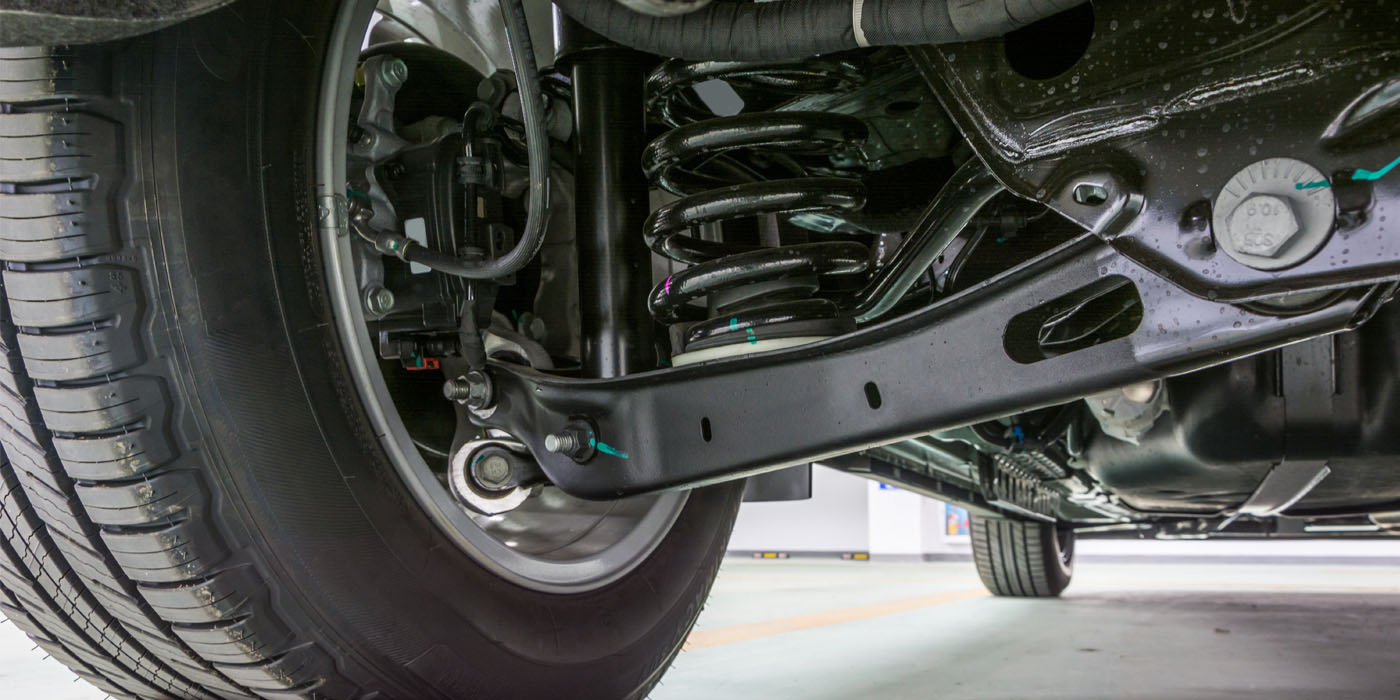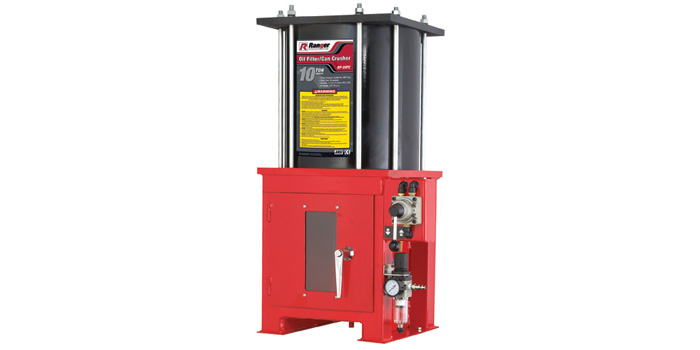I’ve noticed technicians who shy away when they see a warning lamp illuminated on the vehicle’s dash after a collision repair. But with a little understanding, you don’t have to flee a flashing ABS light. Make friends with it instead.
We all dread the unknown. And to many of us in the collision industry, ABS is as foreign to us as bravery is to a Frenchman. Pardon the stereotype. I’m sure there are plenty of brave Frenchmen, just as I’m sure there are plenty of autobody technicians who are willing and able to troubleshoot antilock brake system problems.
On the other hand, there are plenty of techs who aren’t. I’ve actually had technicians tell me, “It’s not my job. I’m a bodyman, not a mechanic.”
To me, that’s a cop out. A collision repair technician today has to be one of the most versatile technicians ever. Let’s face it. We’re faced with damage to any and every conceivable part on a vehicle. Anything that can be exposed to impact (and everything is exposed) may be in need of repairs after a collision – including ABS.
I can’t teach you everything you’ll ever need to know about ABS in one article, but I am going to go through the ABS basics here – and hopefully take away some of that fear of the unknown.
Three Types of ABS
There are basically three types of ABS that I’m going to mention
here. First, we have what’s known as a one-channel ABS. This is as basic as ABS gets. It involves a sensor that senses when the rear wheels are beginning to lock up, signaling the ABS module to lessen the brake pressure to the rear brakes. This allows the rear wheels to keep rolling, thereby enhancing control.
Next, we have three-channel ABS, which consists of one sensor on each of the two front wheels combined with a channel very much like the one-channel ABS. Three-channel ABS has all the benefits of one-channel ABS, in addition to allowing each of the front wheels maximum braking without locking up.
Then there’s the four-channel ABS. This system, as I’m sure you’ve guessed, has sensors on all four corners that provide data to the ABS module, telling it when any or all wheels are in danger of locking up, taking away our ability to control the vehicle.
Although each of the three types of ABS are different, they’re also the same in many ways. To understand, let’s examine how ABS works.
I already touched on the sensor sensing when the wheel is about to lock up. This actually is quite simple because just before the wheel locks up, rapid deceleration occurs. This excessive deceleration is what the module looks at to make its calculations.
This module is sometimes referred to as a controller. That’s a good name for it, since it controls the actions of the pump and valves after calculating wheel speed and relative deceleration on each channel.
The pump does just what its name implies – it pumps up pressure when needed to add pressure to the brake system. The valve, to put it simply, operates to regulate pressure by either opening or closing off pressure when the module determines too much pressure is already there.
So, in effect, if programmed to do so – given these units have pumping and relieving capabilities – a module could effectively stop your vehicle without your even applying pressure to the brake pedal. At least in theory. Actually, these units aren’t designed to apply all the pressure, only to regulate pressure and supplement pressure.
While that mind of yours is likely contemplating ways to wire this to stop your next custom hot rod with a joystick, let’s just stick to figuring out what we need to do to correct collision-related problems in ABS brakes.
Why ABS?
After the ever-so-brief synopsis of ABS, let’s move on to briefly discuss what ABS means to a driver.
We know that if a wheel is skidding, it won’t be controllable (direction or speed). It makes sense, then, that a tire that’s decelerating just before traction loss is the most effective way to stop a vehicle.
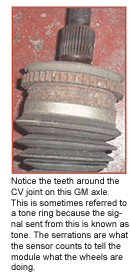
And ABS brakes are improving. It’s true that the early ABS seemed to inhibit fast stopping. In fact, I had many customers comment, “If it wasn’t for those @*%$! antilock brakes, I would’ve been able to stop before I hit that car!” Today, however, ABS does enhance controllability when it’s working correctly.
Before ABS came along, I remember an unfortunate event that involved an acquaintance of mine. “Wayne” was working at one of the competing dealerships in our small community and had been working on 1970’s model pickup. This was a fairly new vehicle when this story took place, so the vehicle in question was in relatively good condition.
After finishing the repair on his latest project, Wayne proceeded to the test drive portion of the repair – in effect, to confirm the repair. During the test drive, Wayne applied the brakes in an aggressive manner, either out of need to avoid a crash or to confirm the vehicle was functioning correctly – and he ended up in a slide. The slide quickly became an immediate lateral stop due to a pothole – turning the slide/stop into a rollover condition. This rollover condition then prompted another rollover condition – in the dealership’s employment of Wayne.
Wayne, you see, was very knowledgeable about auto repair – and about many things, for that matter. This guy had a special gift for turning wood into works of art. He could carve a duck out of a piece of wood that looked more like a duck than a duck. Yet even with such talents, he still couldn’t control a vehicle with skidding tires. None of us can. And that’s why ABS was (and is) such a good thing.
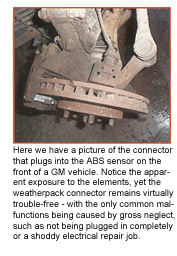
As for Wayne, you might say that after his firing, he got all his ducks in a row. Wayne went on to carve ducks full time and was even recognized as one of the best in his field.
How Do You Fix This Thing?
Although we all now understand the need for safety devices such as ABS brakes, many of us still don’t have the slightest idea how to work on such units.
It’s actually relatively simple. As far as repairing ABS after a crash, my experience has been that it’s usually either a broken component (visually broken) or a broken circuit.
The broken component is relatively simple. If it’s crushed, cracked or mangled, replace it.
On other occasions, I’ve run into sensors on some vehicles that get rusted in place so there’s no way to remove and replace them without breaking the component. Of course, this leads to the replacement of said component.
The broken circuit can sometimes be a little more complex to diagnose. Usually when tearing down a vehicle, you’ll notice torn or chaffed wires, so the obvious would be to check those areas for wiring problems.
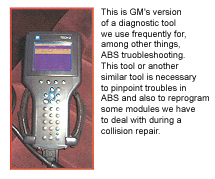
I’ve seen on more occasions than I really want to admit a problem with sensors being plugged in or installed improperly. They’re either left unplugged altogether or somehow not completely seated.
When such a problem occurs, it’s normally indicated by the ABS warning lamp on the dash. Now this can be the bad part: You’ll need a diagnostic device and service manual to help you at this point. Being in a dealership, this is no problem if it’s a system on one of the vehicles we sell. But if it’s one of “the other brands,” I sometimes have to sublet this to someone with the proper diagnostic equipment.
With the proper scan tool, diagnosis is relatively simple. Most of the time, the scan tool will tell you which sensor isn’t operating. So you go to that sensor, check the connection and if it’s good, then the wiring probably has an open somewhere or the component is bad.
Check the wiring as you would any circuit to find the fault. If it’s wiring, it’ll either be open or shorted if it has a malfunction; otherwise the problem will be elsewhere. One other possibility is the odd chance that the vehicle experienced the symptoms prior to the accident. Of course, your customer would’ve noticed it wasn’t working prior to the accident so it “had to be part of the collision damage.”
I’ve seen wires left unhooked in different areas. As a matter of fact, it happened often enough during one time span that my detail man kept commenting that we were going to have to send these guys to “plug in and hook up” school so they’d remember to hook things up.
Another problem I’ve seen in the shop involved some burred threads on a new knuckle. The technician installed a sensor in the new knuckle and thought it was tight. To his dismay, the vehicle then had an ABS lamp illuminated on the dash. We hooked up the scan tool and found an indication that the left front ABS sensor wasn’t functioning properly. After further examination, we found the threads in the new knuckle had just enough of a burr on them to impede the bolt from going into the knuckle. This, in effect, caused excessive clearance between the tone ring and the sensor. And this caused a weak signal to the module, telling the module there was a problem. Putting a little more torque to the bolt allowed the sensor to seat where it belonged, next to the tone ring, and fixed the lamp-indicated problem.
ABSolutely Clear?
If you have an opportunity to diagnose an ABS problem, go for it. I think you’ll be surprised how easily you can come up with a diagnosis if you just take the time to use a little common sense.
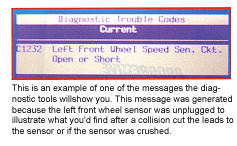
We also have somewhat of an advantage in the collision repair business when working on ABS brakes. Most likely, the problems we’re trying to repair weren’t there prior to the accident. If you have an ABS problem, something’s most likely hit, torn or otherwise physically damaged. Most of the time, a collision won’t cause an ABS component to simply burn out, so look for the obvious bent or broken components.
I know I’ve spoken in pretty simple terms here, but it reflects my thoughts on the subject: simple. By following directions from a service manual, even someone with a simple mind such as myself can stumble through an ABS repair.
Contributing editor Keith Combs is the body shop manager at Bill Roberts Chevrolet, where he’s been employed for 25 years. He was named GM/ASE Master Collision Repair/Refinish Technician of the year 2000 and was one of the first to achieve GM’s World Class Technician status in 2002.







